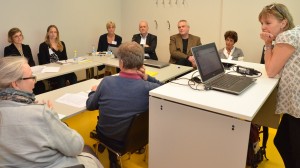Partners in EDC-MixRisk
The EU project EDC-MixRisk involves participation from seven Swedish universities*, five European universities and one American university.
 EDC-MixRisk is based on a consortium consisting of a unique combination of epidemiologists, chemists, biostatisticians, medical doctors, molecular biologists, and experimental and regulatory toxicologists. The consortium combines outstanding expertise and resources in public-health science, analysis of environmental chemicals, advanced biostatistics, animal model systems, stem cell research, epigenetics, risk assessment, and ethics. Strong synergies between these disciplines will address the objectives of the project appropriately.
EDC-MixRisk is based on a consortium consisting of a unique combination of epidemiologists, chemists, biostatisticians, medical doctors, molecular biologists, and experimental and regulatory toxicologists. The consortium combines outstanding expertise and resources in public-health science, analysis of environmental chemicals, advanced biostatistics, animal model systems, stem cell research, epigenetics, risk assessment, and ethics. Strong synergies between these disciplines will address the objectives of the project appropriately.
Partners and key contributors
Karolinska Institutet, Stockholm, Sweden
Partner 1
Karolinska Institutet (KI) ranks as one of the world’s leading medical universities, which today account for 40 percent of all medical research in Sweden.
Key contributors to activities are: Åke Bergman, Professor, PhD; Joëlle Rüegg, PhD; Pauliina Damdimopoulou, PhD; Mattias Öberg, PhD; Konstantin Svechnikov, MD, PhD; and Elina Drakvik.
Read more on our project in Swedish: EDC-MixRisk_Svenska
Karlstad University, Karlstad, Sweden
Partner 2
Karlstad University has approximately 16 000 students and 1 150 employees within health, social sciences, humanities, natural science and technology.
Key contributors to activities are: Carl-Gustaf Bornehag, Professor, PhD; Maria Unenge Hallerbäck, PhD; Sverre Wikström, MD, PhD; Daniel Lin, Associate professor, PhD.
Gothenburg University, Gothenburg, Sweden
Partner 3
Gothenburg University have 37 000 students and 6 000 employees making it a large and inspiring place to work and study, with a continuous flow of new knowledge and ideas.
Key contributors to activities are: Joachim Sturve, PhD, Assoc. professor.
Lund University, Lund, Sweden
Partner 4
Lund University has a long and vibrant history covering almost 350 years of teaching. It has evolved from just a few hundred students to around 47 000 students and a position of excellence in international teaching and research.
Key contributors to activities are: Christian Lindh, Assoc. professor; Karin Broberg Palmgren, Professor, Lars Rylander, Assoc. professor; and Anna Rignell-Hydbom, PhD.
Stockholm University, Stockholm, Sweden
Partner 5
Stockholm University is among the world’s 100 foremost institutions and has more than 70 000 students, 1800 PhD students and 5500 employees.
Key contributors to activities are: Christina Rudén, Professor, PhD; Thuy Bui, PhD; and Huan Shu, PhD.
Uppsala University, Uppsala, Sweden
Partner 6
Uppsala University is a comprehensive research university and research is pursued across nine faculties that include 41 000 students, 6 500 teachers and researchers, and more than 500 full professors.
Key contributors to activities are: Maria Jönsson, Assistant Professor, PhD; Björn Brunström, Professor, PhD; Anna Mattsson, PhD; and Anna Mentor, PhD student .
Centre National de la Recherche Scientifique, Paris, France
Partner 7
Centre National de la Recherche Scientifique is a state-funded science and technology establishment with research units located throughout France.
Key contributors to activities are: Barbara A Demeneix, Professor, PhD; Jean Baptiste Fini, PhD; and Sebastien LeMevel, PhD.
Read more on our project in French: EDC-MixRisk_Français
University Hospital Leipzig, Leipzig, Germany
Partner 8
The University of Leipzig is the second oldest university in Germany with about 30 000 students enrolled in courses in 14 faculties. More than 600 professors teach and study at the university.
Key contributors to activities are: Wieland Kiess, Professor, MD.
Read more on our project in German: EDC-MixRisk_Deutsch
School of Health Sciences, University of Athens, Athens, Greece
Partner 9
The National and Kapodistrian University of Athens is the biggest and oldest Greek university, founded in 1837, comprising of 32 faculties that include more than 90 000 undergraduate students, 7 715 master and 6 540 PhD students as well as 1864 faculty members.
Key contributors to activities are: Efthymia Kitraki , Professor, PhD; Antonios Stamatakis, Associate Professor, PhD; Anastasia Repouskou, PhD; and Emily Panagiotidou, Msc.
Read more on our project in Greek: EDC-MixRisk_στα ελληνικα
National Institute for Health and Welfare, Helsinki, Finland
Partner 10
The National Institute for Health and Welfare is a research and development institute more than a thousand experts in the health and welfare research.
Key contributors to activities are: Hannu Kiviranta, PhD; Panu Rantakokko, PhD; Päivi Ruokojärvi, PhD; and Riikka Airaksinen, PhD.
Read more on our project in Finnish: EDC-MixRisk_Suomi
The European Institute of Oncology, Milan, Italy
Partner 11
The Istituto Europeo di Oncologia (European Institute of Oncology, IEO, founded in 1994, was established to implement an innovative model for health and advanced research in oncology and the life sciences.
Key contributors to activities are: Giuseppe Testa, MD, PhD.
Read more on our project in Italian: EDC-MixRisk_Italiano
Mount Sinai School of Medicine, New York, NY, USA
Partner 12
The Department of Preventive Medicine at Mount Sinai School of Medicine is among the largest medical school departments of preventive medicine in the U.S., with 57 full-time faculty, 137 adjuncts and voluntary faculty and 265 staff.
Key contributors to activities are: Chris Gennings, Professor, PhD; and Eva Tanner, PhD.
Örebro University, Örebro, Sweden
Partner 13
Örebro University is a modern, broad-based university with internationally prominent research, with 15 100 students and 1350 staff.
Key contributors to activities are: Eewa Nånberg, Professor, PhD.
* All the Swedish applicants, independent of home universities, have been part of the Swedish Toxicology Sciences Research Center (Swetox), a unique academic interdisciplinary collaboration between 11 Swedish universities.
